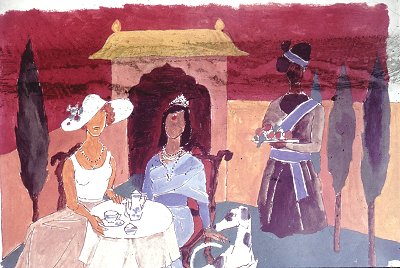Contribute
| South Asian Art - The Indian-ness Of Art |
Razvin Namdarian
04/27/2010
The
Indian-ness of Art! As the headlines screamed controversies
surrounding M F Hussain acceptance of Qatari citizenship, one stops to wonder
at this strange ‘possessiveness’ that seemed to have gripped the Indian media.
At age 95 Hussain, a nomad at heart, had been reduced to the status of a
refugee. His country of birth and nationality was no longer a safe place given
that he had inadvertently hurt the sentiments of fundamental religious groups.
Without derailing into the mire of artistic freedom and censorship, let us
consider that it was but human of Hussain to need a sense of security and
belonging. It raises another question; does the fact that he now is a Qatar
national make his art any less Indian? Does an artist’s passport lead to an
automatic compartmentalisation of his art? In today’s global amalgamation while
cultural differences do exist, there seems to a greater desire amongst artists
to break free of the strings of national boundaries and enter into a state of
flux with global sensitivities. There is an ‘artistic osmosis’ as it were where
ideas and concepts move fluidly and without restraint across borders – a
parallel a-political universe as it were.
This is seen best in the case of artworks created by the Indian Diaspora
of contemporary artists who share their common lineage but have also grown into
the cultures of their adoptive countries. What emerges therefore is art that
cannot be explicitly stamped as ‘Made in India’ but does have strong Indian
overtones. Take for instance the works of Chitra Ganesh who while using tales
out of the popular Indian children’s comics, ‘Amar Chitra Katha’ nevertheless
speaks a global language through her works. Does
the artist’s name decide if his art is Indian? If this were true then perhaps
one of the most famous British artists with an Indian name – Anish Kapoor,
should have all his works labelled Indian! Which anyone who has seen his
sculptures that redefine space and light would vehemently refute. Or does it have to do with the physical
boundary within which art is created? Most of S H Raza’s and those of Sakti
Burman are created in France; does that make their art French? Raza had once
said, “I have not let go of anything that is important from my
own country. I've remained Indian, not become French!†Speaking of the French, Ariane Mercier (an artist
associated with bCA Galleries) though being a French national creates artworks
that employ the style of miniature paintings and are replete with Indian
imagery. Her delicately balanced works speak of the colours and life of
Rajasthan where she studied Indian art with Mahaveer Swami and has even
exhibited her works with him. Seeing their works in unison one realizes the
effect of a new culture and style fusing with an artist’s personal experiences
and background. Besides
how ‘Indian’ is Indian art anyway? This is a country that has seen a steady
stream of invaders who have then set up base in the country – Indian art is
nothing if not an amalgamation of global influences. This process began from
the time of the Mughals with Persian calligraphic and palette influences
seeping into traditional Indian folk art. Indian art has not remained immune to
other Asian influences as elements from China and Japan are seen especially in
Buddhist art. There are instances of Chinese lacquer ware to be seen in the
works of Anjolie Ela Menon as well. The British brought their own sense of
style and rendering. In fact much of modern day contemporary art is a
reflection of European influence as most art schools still continue with the
erstwhile standards of teaching. In this
sense, Indian art though having its roots in a common cultural ethos still
cannot be termed ‘purely Indian’ in its style and execution. In fact, if
defined in those terms only the traditional arts such as Warli and Madhubani
remain now Indian in an ‘unblemished’ manner. In an interview, Atul Dodiya, one of the
most recognisable names of Indian contemporary art had said, “Ultimately,
only that art which is strongly rooted will have universal appeal. I live in Mumbai
and it is from this perspective that I create. Ultimately, all art is
culture-specific yet has many cross-cultural references." An artist, in a childlike manner, will but speak
the language he has grown with. The bounty of experiences and wealth of traditions
that Indian artists are exposed to will necessarily influence their art and
form the foundation of their artwork. A purposeful and deliberate use of Indian
symbology does not make a painting Indian, the hidden language that the work
speaks definitely does. As Husain Saab makes Qatar his adopted home during his
final years his son, filmmaker-writer-painter Owais Husain, says, “... You can
take M.F. Husain out of India. But you can’t take India out of M F
Husain.†~ Razvin
Namdarian
You may also access this article through our web-site http://www.lokvani.com/
